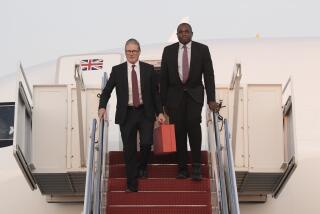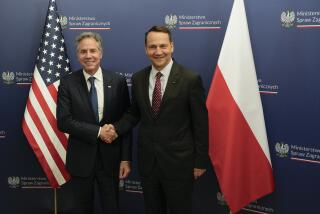U.S., Soviet Negotiators Meet Today in Bid to Narrow Gap on Nuclear Arms Issues
- Share via
WASHINGTON — As the pace of U.S.-Soviet talks has stepped up, negotiators meet again here today in an effort to narrow the differences between the two superpowers on nuclear arms issues before the next summit meeting between President Reagan and Soviet leader Mikhail S. Gorbachev.
The two-day session is the latest in an expanded series of U.S.-Soviet talks on various matters, including arms control and conflicts in Third World regions, which are intended to lay the groundwork for a scheduled Sept. 19-20 meeting between Soviet Foreign Minister Eduard A. Shevardnadze and Secretary of State George P. Shultz. The Shevardnadze-Shultz meeting, in turn, will focus largely on a summit date and agenda.
Among the other U.S.-Soviet talks, discussions on nuclear testing resumed earlier this week, while formal and detailed negotiations toward a new strategic arms agreement resume in Geneva on Sept. 18, when a new U.S. proposal is to be presented.
Significant Accords Sought
The scope and depth of the arms discussions suggest that both sides are now serious about reaching some significant agreements in principle at the summit, expected in December or early 1987, which could be formalized into new treaties before Reagan leaves office, two senior Administration officials said Thursday.
Most promising for the summit, they said, would be statements of principle on a new strategic arms agreement, on an intermediate-range missile agreement and on so-called “risk-reduction centers” in both countries.
But, though progress toward such accords seems well under way, it could be derailed by some unforeseen event, such as the present flap over the Soviet arrest of American journalist Nicholas Daniloff on spy charges, one official warned.
The arms meeting that starts here today continues talks begun in Moscow in August. It grew out of a letter from Gorbachev to Reagan proposing wide-ranging talks by experts on arms control and regional conflicts such as those in Afghanistan, Angola and other areas where the United States and the Soviet Union are backing opposing forces.
“It’s puzzling that Gorbachev asked for these meetings. . . . The Soviets have not had anything new or interesting to say,” one official said. “It seems primarily to be setting the stage for the summit” rather than an effort to significantly narrow differences during the actual discussions, he added.
Little More Expected
No progress was made in Moscow toward eliminating roadblocks to new agreements, officials said. Although some advancement from the current round of talks here could not be ruled out, little more was expected.
There are already “elements in both the U.S. and Soviet positions that have much in common,” however, and these could lead to a summit agreement “containing substance somewhere between last November and Vladivostok,” he said.
The Reagan-Gorbachev summit last November in Geneva produced cautious agreement to accelerate negotiations on offensive nuclear arms and space defense weapons. The leaders called for “early progress” toward 50% reductions in the nuclear arms of both sides and to “the idea of an interim INF (intermediate-range nuclear forces) agreement.”
The Vladivostok accord, on the other hand, was more specific and became the basis for the 1979 second strategic arms limitation treaty five years later. Signed in 1974 by former President Gerald R. Ford and the late Soviet President Leonid I. Brezhnev, it declared that a new strategic arms agreement, lasting to 1985, was to be concluded based on each side having the same limit on the number of “delivery vehicles”--land-based missiles, submarine-based missiles and bombers--with sub-ceilings on the number of missiles that could carry multiple warheads.
Key Difference
This Vladivostok agreement compromised a key difference between the U.S. and Soviet positions. The United States wanted sub-limits on each kind of weapon, particularly on huge Soviet intercontinental land-based missiles, while the Soviets called only for a ceiling on total weapons, with each side free to decide how many missiles and bombers it would build. This same difference--over so-called “aggregation”--besets the negotiations on a new strategic arms agreement today.
Optimism about a summit agreement on intermediate-range missiles has been steadily growing in recent months as re-examination of the positions of both sides show relatively small differences. The U.S. proposal calls for eliminating these 1,000-3,000-mile-range missiles from Europe and Asia; the Soviets would eliminate them from Europe and freeze them in Asia, as well as halt U.S. help to modernize the British nuclear force.
‘Global Ceilings’
One possible compromise would be to set “global ceilings” for these missiles. Initial reductions would cut U.S. and Soviet arsenals in Europe by half, with similar cuts of Soviet missiles in Asia. The United States would retain the right to deploy on this continent as many missiles as the Soviet Asian force, but the U.S. missiles would be largely impotent because of their short range.
“Risk-reduction” centers in both capitals would be staffed by American and Soviet experts. The aim of these is to lessen the risk of accidental war, as might occur if a salvo of test missiles strayed. Through such centers, both sides could notify each other about missile tests and strategic exercises, as well as improve communication between the U.S. and Soviet military.
The modified U.S. arms proposal, yet to be approved by Reagan but representing the consensus within the Administration, probably will not be discussed with the Soviet officials at the current meeting but will be presented to Soviet negotiators for the first time Sept. 18 in Geneva.
In it, the United States moves closer to the overall numerical ceiling on weapons offered by the Soviets. But this appears to do little, so far as is known, to solve the differences on aggregation, as well as other outstanding points of contention.
Specifically, the previous U.S. ceiling of 6,000 missile warheads would rise to 7,500, compared with the Soviet proposal of 8,000 warheads and bombs for both sides.
More to Read
Sign up for Essential California
The most important California stories and recommendations in your inbox every morning.
You may occasionally receive promotional content from the Los Angeles Times.










